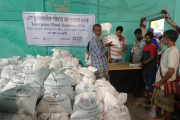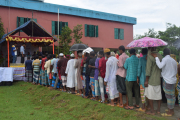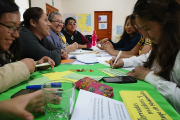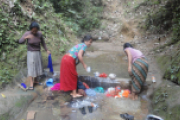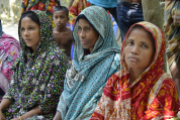The People's Republic of Bangladesh has a population of about 165 million, according to the Human Development Report 2021/2022. Although the poverty rate is declining, about 24 % of the population lived in poverty in 2018, according to the World Bank. Cox's Bazar in the south of the country is home to the world's largest refugee camp. About one million Rohingya are seeking refuge there from violence in their home country of Myanmar. Living conditions are precarious and there are repeated fires in the camp. In general, Bangladesh has a subtropical monsoon climate. Due to its location within the tropics and by the sea in a tectonically unstable zone, the people are repeatedly threatened with natural disasters such as cyclones, landslides, earthquakes and floods.
Projects in this country
Emergency aid for the population affected by Cyclone Remal
The project is aimed at the population affected by Cyclone Remal in the Mongla and Satkhira areas of southern Bangladesh. The main focus is on the most vulnerable groups who have suffered considerable damage to their homes, agricultural land, infrastructure and lives.Sustainable food security and hygiene standards
The Saghata district in the north of Bangladesh is heavily dependent on agriculture. The region is bordered by large rivers that regularly burst their banks and destroy farmers' harvests. This and other extreme weather conditions lead to food insecurity. At the same time, there is a shortage of...Strengthening resilience and promoting sustainable livelihoods
The Satkhira district, in the south of Bangladesh, borders directly on the world's largest mangrove area, the Sundarbans. Life here is rural, and large sections of the population are socially disadvantaged, have low incomes and are cut off from state support and development. The population's low...Community-based development to alleviate poverty
The majority of the target group in Gobindaganj in northern Bangladesh live in extreme poverty and are unable to improve their own living situation in the long term without external help. In the course of establishing self-help groups, various training courses are offered and carried out. These...Preparation for humanitarian emergencies
Local non-governmental organisations are the first and last to provide on-site assistance and support reconstruction in the event of a disaster. For this reason, a total of ten local partner organisations in particularly disaster-prone countries are being given specialist training to enable them to...Water, hygiene, health
In order to sustainably improve the living situation of 1,200 disadvantaged families in the Chittagong Hill Tracts, Sign of Hope supports the local partner organisation in the rehabilitation of drinking water wells as well as the comprehensive sensitisation of the population in the areas of hygiene...Good nutrition, good income
2,000 women earn their own income and generate a healthy diet through vegetable cultivation and other activities. In addition, they learn to organise themselves, demand their rights and better protect themselves from the consequences of natural disasters.Country reports
There is currently no content.


 Donate now
Donate now
